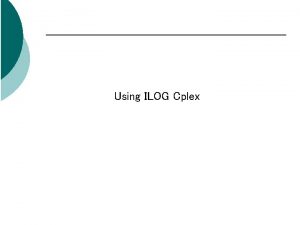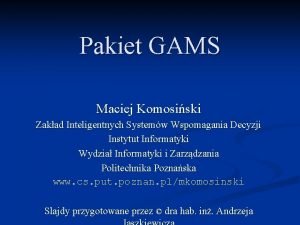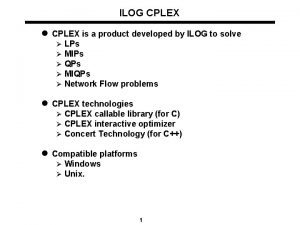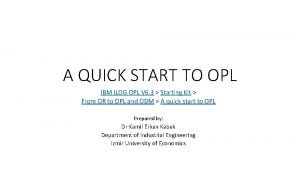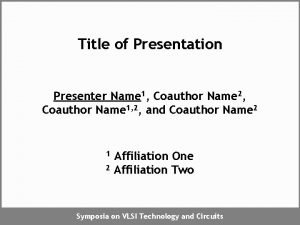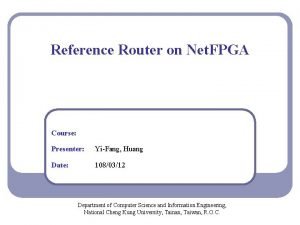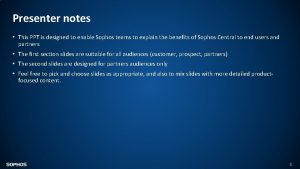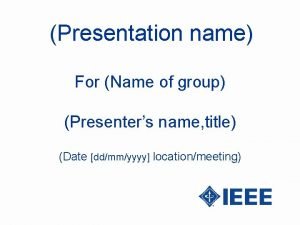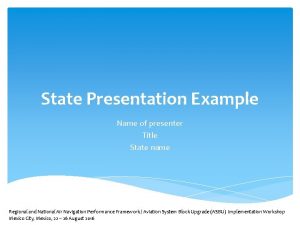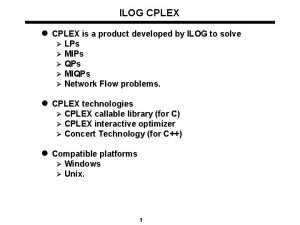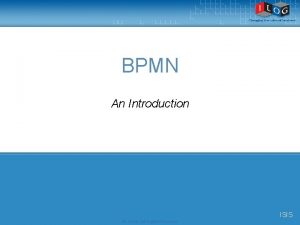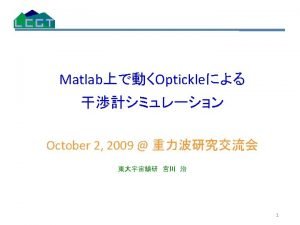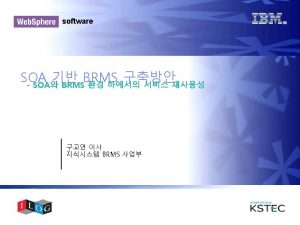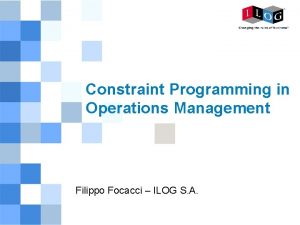ILOG CPLEX introduction Presenter Mengyen Li Outline Introduction





















![Formulation X • FS constraint: • f(ma) f(mb) (ma[bit]) (mb[bit]) ma a[0 a[1 a[2 Formulation X • FS constraint: • f(ma) f(mb) (ma[bit]) (mb[bit]) ma a[0 a[1 a[2](https://slidetodoc.com/presentation_image_h2/3d707694ff6b3de2762341ffb752bc26/image-22.jpg)















![Problem Encoding • X variables: x[minterm][bit] • example : x 71 means 7 -th Problem Encoding • X variables: x[minterm][bit] • example : x 71 means 7 -th](https://slidetodoc.com/presentation_image_h2/3d707694ff6b3de2762341ffb752bc26/image-38.jpg)


- Slides: 40

ILOG CPLEX introduction Presenter: Meng-yen Li

Outline • • • Introduction Using the interactive interface Read problem from file LP format Demo with FS problem

Introduction • ILOG CPLEX is an optimization package. • Usually shortened as “cplex” • Named after Simplex method and C language. • Originally developed by Robert E. Bixby. • Now IBM has the acquisition of ILOG CPLEX. • CPLEX was acquired by ILOG in 1997 • ILOG was acquired by IBM in 2009

Capability • • • CPLEX can solve… Very large linear programming problems(LP) Mixed integer programming problems(MIP) Quadratic objective programming problems(QP) Quadratic constraint programming problems(QCP)

Reference • “ILOG CPLEX <Version> Getting Started” • Ref. - “ILOG CPLEX 11. 0 Getting Started”, 2007 • For CPLEX starter. • “ILOG CPLEX <Version> File Formats” • Ref. - “ILOG CPLEX 10. 0 File Formats”, 2006 • For knowing file format detail, especially LP format. • “ILOG CPLEX <Version> User’s Manual” • Ref. - “ILOG CPLEX 9. 0 User’s Manual”, 2003 • For manually using CPLEX Classes and Library in C++. • • • You can get these documents by Google. Current version is 12. 1. 0 Easy / Hard

How to use • CPLEX is currently installed on eda union 13 • Login to edaunion. ee. ntu. edu. tw: 40063 • Just directly execute cplex – Type cplex • Unfortunately, the License is only for one user. • So if others are using or link dead when using, you may see error message from ILM(license manager)

Interactive Interface r 97160@eda. U 13: ~$ cplex IBM ILOG License Manager: "ntu-taiwan " is accessing CPLEX 12 with option(s): "e m b q use=1 Maintenance. End=20121031 ". Welcome to CPLEX Interactive Optimizer 12. 1. 0 with Simplex, Mixed Integer & Barrier Optimizers 5724 -Y 48 (c) Copyright IBM Corp. 1988, 2009. All Rights Reserved. CPLEX is a registered trademark of IBM Corp. Type 'help' for a list of available commands. Type 'help' followed by a command name for more information on commands. CPLEX>

Example with manually input CPLEX> enter example Enter new problem ['end' on a separate line terminates]: maximize x 1 + 2 x 2 + 3 x 3 subject to -x 1 + x 2 + x 3 <= 20 x 1 - 3 x 2 + x 3 <= 30 bounds 0 <= x 1 <= 40 0 <= x 2 0 <= x 3 end

Example with manually input CPLEX> enter example Keyword enter with problem name example Enter new problem ['end' on a separate line terminates]: maximize x 1 + 2 x 2 + 3 x 3 subject to -x 1 + x 2 + x 3 <= 20 Problem x 1 - 3 x 2 + x 3 <= 30 Objective Function maximize Subject to constraints subject to bounds Variable bounds 0 <= x 1 <= 40 end to finish input problem 0 <= x 2 0 <= x 3 end

Solving the problem CPLEX> optimize Tried aggregator 1 time. No LP presolve or aggregator reductions. Presolve time = 0. 00 sec. Iteration log. . . Iteration: 1 Dual infeasibility = Iteration: 2 Dual objective = 0. 000000 202. 500000 Dual simplex - Optimal: Objective = 2. 0250000000 e+02 Solution time = 0. 00 sec. Iterations = 2 (1)

View solution CPLEX> display solution variables x 1 -x 3 Variable Name Solution Value x 1 40. 000000 x 2 17. 500000 x 3 42. 500000

Read problem from file • Manually input is too tedious. • We can read the problem from file if it is stored in LP format file. • You can read in many ways: • read (then to be prompted to input file name) – example (then to be prompted to input file format) – lp • read example lp (same to above but without prompt) • read example. lp (specify extension also works)

LP format Keyword abbreviation default name enter read e r by manually input (input filename) maximize minimize max min (obj) subject to st (c 1 …. cn) bounds end

LP format: variable naming • The variable name cannot be longer than 255 characters • All alphanumeric characters (a-z, A-Z, 0 -9) and certain symbols: ! " # $ % & ( ) , . ; ? @ _ ‘ ’ { } ~ can be used. • Any combinations are allowed except the followings. • Cannot start with numbers or period(. ) • Cannot start with e/E with another number or e • (because e is reseverd for exponents and equal sense) • Some examples: – O x 123, x@#$ , #4 x. 3 e, Example – X e 2, eels, . 123, 3 x 4

LP format: constraint naming As previous table shows The default name for objective function is obj. The default name for constraints is c 1 … cn. You can change by adding labels before the linear (in)eqaulities. • example: • • max mymax: x 1 + 2 x 2 + 3 x 3 st time: -x 1 + x 2 + x 3 <= 20 labor: x 1 - 3 x 2 + x 3 <= 30

LP format: input limit • Any line with more than 510 characters is truncated. • You can enter linear (in)equalities on separate lines, but without cutting the variables. • example: – correct input time: -x 1 + x 2 + <return> x 3 <= 20 <return> labor: x 1 - 3 x 2 + x 3 <= 30 <return> – incorrect input time: -x 1 + x 2 + x <return> 3 <= 20 <return> labor: x 1 - 3 x 2 + x 3 <= 30 <return>

LP format: sense • • • X 1 – 3 x 2 + x 3 <= 30 Yellow part is called sense. Blue part is called Right Hand Side(RHS). CPLEX parse constraints by these key parts. So if you add ; after a line(like c/c++) will get this warning. – Warning, line 55: Characters after RHS value are ignored. Sense = Input format <= >= = Synonym <, <=, =<, l(less) >, =>, >=, g(greater) =, e(equal) Note < is interpreted as <= by cplex > is interpreted as => by cplex

LP format: bounds • Variable bounds can enter as – ln <= xn <= un • You can also separately enter the bounds – ln <= xn – xn =< un • Default setting – lower bound: 0 – upper bound: +∞ • For infinity, set the bounds as +infinity(+inf) / -infinity(-inf) • also you can use free to indicate no bounds – x 7 free – same as –inf <= x 7 <= +inf

LP format: Integer • Add section general/binary to list which variable is integer/0 -1 integer. • General/Generals/Gen is all acceptable. • Binary/Binaries/Bin is all acceptable.

LP format: Mixed Integer Maximize obj: x 1 + 2 x 2 + 3 x 3 + x 4 Subject To c 1: - x 1 + x 2 + x 3 + 10 x 4 <= 20 c 2: x 1 - 3 x 2 + x 3 <= 30 c 3: x 2 - 3. 5 x 4 = 0 Bounds 0 <= x 1 <= 40 2 <= x 4 <= 3 General x 4 Binary x 2 End

Demo • Using CPLEX to solve FS problem • Problem Input: X 0 X 1 F 0 0 1 0 0 2 0 1 3 0 1 0 1 0 1 1 1 2 1 0 3 1 0 fsp 1. lp(infeasible) fsp 2. lp(has solution)
![Formulation X FS constraint fma fmb mabit mbbit ma a0 a1 a2 Formulation X • FS constraint: • f(ma) f(mb) (ma[bit]) (mb[bit]) ma a[0 a[1 a[2](https://slidetodoc.com/presentation_image_h2/3d707694ff6b3de2762341ffb752bc26/image-22.jpg)
Formulation X • FS constraint: • f(ma) f(mb) (ma[bit]) (mb[bit]) ma a[0 a[1 a[2 a[3 ] ] • (ma[bit]) (mb[bit]) | (ma[bit]) (mb[bit]) | 1 mb b[0 b[1 b[2 b[3 ] ] ( (ma[bit]) (mb[bit]) 1) ( (mb [bit]) (m a[bit]) 1) • At first I didn’t know how to write a Linear Constraint for this, so I wrote a Quadratic Constraint instead. • | (ma[bit]) (mb[bit]) | 1 ( (ma[bit]) (mb[bit]) )2 1 F 1 0 1 1 0 0

Convert constraints in MIQCP min dummy Use dummy variable for there’s no objective function x grc group/row/column z grrc group/pairs of row/column problem x x 0 x 1 encode f � 0 0 x 001 x 100 1 1 1 0 x 011 x 100 0 2 2 0 x 021 x 100 1 3 3 0 x 031 x 100 1 4 0 1 x 000 x 001 x 110 0 5 1 1 x 010 x 011 x 110 1 6 2 1 x 020 x 021 x 110 0 7 3 1 x 030 x 031 x 110 0 Use to comment a line This problem is infeasible. And if this bit changes to 0 It will become feasible

Convert constraints in MIQCP st full symmetry property pair 01 FSpair 01: [ x 000 * x 000 + x 000 * x 001 + x 000 * x 100 - x 000 * x 011 - x 000 * x 100 + x 001 * x 001 + x 001 * x 100 - x 001 * x 011 - x 001 * x 100 + x 100 * x 001 + x 100 * x 100 - x 100 * x 011 - x 100 * x 100 - x 010 * x 001 - x 010 * x 100 + x 010 * x 011 + x 010 * x 100 - x 011 * x 001 - x 011 * x 100 + x 011 * x 011 + x 011 * x 100 - x 100 * x 001 - x 100 * x 100 + x 100 * x 011 + x 100 * x 100 ] >= 1 this is the infeasible one’s FS QC(quadratic constraint) for example, other QC are omitted Quadratic terms must put inside of square brackets []

Convert constraints in MIQCP x 0 encode x 0 pair 01 ENCODEx 0 bit 0 pair 01 LB: x 000 + x 010 - 2 z 0010 >= -1 ENCODEx 0 bit 0 pair 01 UB: x 000 + x 010 - 2 z 0010 <= 0 ENCODEx 0 bit 1 pair 01 LB: x 001 + x 011 - 2 z 0011 >= -1 ENCODEx 0 bit 1 pair 01 UB: x 001 + x 011 - 2 z 0011 <= 0 ENCODEx 0 pair 01: 2 z 0010 + 2 z 0011 - x 000 - x 010 - x 001 - x 011 >= 1 (… from pair 01 to pair 23) x 1 encode x 1 pair 01 ENCODEx 1 bit 0 pair 01 LB: x 100 + x 110 - 2 z 1010 >= -1 ENCODEx 1 bit 0 pair 01 UB: x 100 + x 110 - 2 z 1010 <= 0 Cplex interpret > 0 as >= 0 ENCODEx 1 pair 23: 2 z 1010 - x 100 - x 110 >= 1 here need change to >=1

Convert constraints in MIQCP bin dummy x 0 x 001 x 010 x 011 x 020 x 021 x 030 x 031 x 1 x 100 x 110 z 0 z 0011 z 0020 z 0021 z 0030 z 0031 z 0120 z 0121 z 0130 z 0131 z 0230 z 0231 z 1 z 1010 end Remember to add end at last line

Use the interactive interface CPLEX> read fsp 1. lp Problem 'fsp 1. lp' read. Read time = 0. 00 sec. CPLEX> display problem stats Problem name: fsp 1. lp Variables : 24 [Binary: 24] Objective nonzeros : 1 Linear constraints : 33 [Less: 13, Greater: 20] Nonzeros : 117 RHS nonzeros : 20 Quadratic constraints: 16 [Greater: 16] Linear terms : 0 Quadratic terms : 256 RHS nonzeros : 16

Use the interactive interface Command needed not to type in full if CPLEX> opt the shortened one is not ambiguous. (…message too long so omitted here) For example, read can also just type r. MIP - Integer infeasible. Current MIP best bound is infinite. Solution time = 0. 12 sec. Iterations = 350 Nodes = 68 (Change the problem and rewrite constraints, store in fsp 2. lp) CPLEX> r fsp 2. lp CPLEX> opt (…message too long so omitted here) Solution pool: 1 solution saved. MIP - Integer optimal solution: Objective = 0. 00000 e+00 Solution time = 0. 01 sec. Iterations = 37 Nodes = 0

Use the interactive interface CPLEX> display sol var * Shortened for command display solution variables * Incumbent solution * is a wildcard character which means Variable Name Solution Value any matching characters x 100 1. 000000 that is, display all variables x 020 1. 000000 x 031 1. 000000 x 010 1. 000000 x 011 1. 000000 (…other auxiliary z variables are omitted here) z 1010 1. 000000 All other variables matching '*' are 0.

Solution for FS • CPLEX showed a solution to the problem – x 100 x 020 x 031 x 010 x 011 are 1, others are 0 • We got the solution! X 0 X 1 Y 0 0 1 1 1 0 1 1 1 0 0 0 0 1 0 0

Formulation • But now I know how to formulate in Linear Constraint. • |x y| 1 ( (x-y) + M*b 1 ) ( (y-x) + M*(1 -b) 1 ) ( (x-y) + M*b 1 ) ( (y-x) - M*b 1 -M ) • x, y +Integer, b Binary, M is a large enough +integer. • Because |x-y| Max(x, y) (∵ x, y +Integer) • Let M = #bit + 1

FS in Linear Constraint full symmetry property #bit =3, M=4 FSpair 02 p: x 000 + x 001 + x 100 - x 021 - x 100 + 4 fs 02 >= 1 FSpair 02 n: x 020 + x 021 + x 100 - x 001 - x 100 - 4 fs 02 >= -3 FSpair 03 p: x 000 + x 001 + x 100 - x 031 - x 100 + 4 fs 03 >= 1 FSpair 03 n: x 030 + x 031 + x 100 - x 001 - x 100 - 4 fs 03 >= -3 FSpair 05 p: x 000 + x 001 + x 100 - x 011 - x 110 + 4 fs 05 >= 1 FSpair 05 n: x 010 + x 011 + x 110 - x 001 - x 100 - 4 fs 05 >= -3

FS in Linear Constraint CPLEX> r fsp 3. lp Problem 'fsp 3. lp' read. Read time = 0. 00 sec. CPLEX> dis pro sta Problem name: fsp 3. lp Variables : 39 [Binary: 39] Objective nonzeros : 1 Linear constraints : 63 [Less: 13, Greater: 50] Nonzeros : 275 RHS nonzeros : 50 Variables : Min LB: 0. 000000 Max UB: 1. 000000 Objective nonzeros : Min : 1. 000000 Max : 1. 000000 Linear constraints : Nonzeros : Min : 1. 000000 Max : 4. 000000 RHS nonzeros : Min : 1. 000000 Max : 3. 000000

FS in Linear Constraint CPLEX> opt Tried aggregator 1 time. (…) Root node processing (before b&c): Real time = 0. 01 Parallel b&c, 8 threads: Real time = 0. 00 Sync time (average) = 0. 00 Wait time (average) = 0. 00 ------Total (root+branch&cut) = 0. 01 sec. Solution pool: 1 solution saved. MIP - Integer optimal solution: Objective = 0. 00000 e+00 Solution time = 0. 01 sec. Iterations = 60 Nodes = 0

FS in Linear Constraint CPLEX> dis sol var * Incumbent solution Variable Name Solution Value x 000 1. 000000 x 001 1. 000000 x 021 1. 000000 x 030 1. 000000 x 110 1. 000000 (…) All other variables matching '*' are 0.

Solution for FS • CPLEX showed another solution to the problem – x 000 x 001 x 021 x 030 x 110 are 1, others are 0. – It’s in fact a complement encoding compare to QCP’s. X 0 X 1 Y 0 0 1 1 1 0 0 0 1 1 0 1 0 1 1 0 0 1 1 1 0 1 0 0 1 1 0 0 1 0 solution from QCP formulation solution from LP formulation

FS: maxmize multivalue f • Problem Input: X F 0 0 0 2 1 1 2 2 3 3 4 0 5 2 6 2 7 0 fsp 5. lp(both function FS feasible) fsp 6. lp(both function FS feasible)
![Problem Encoding X variables xmintermbit example x 71 means 7 th Problem Encoding • X variables: x[minterm][bit] • example : x 71 means 7 -th](https://slidetodoc.com/presentation_image_h2/3d707694ff6b3de2762341ffb752bc26/image-38.jpg)
Problem Encoding • X variables: x[minterm][bit] • example : x 71 means 7 -th minterm’s “ 1 -th” bit • All start from 0! • Y variables: b[minterm][bit]

Formulation For each pair of two minterm row of X. If Y-multivalue same, skip. Add LP constraint of b-encoding not same summation not same Min m 0+m 1+… b 00 + b 10 - 2 z >= -1 b 00 + b 10 - 2 z <= 0 2 z - b 00 - b 10 >= 1 =. . . sum 2 - sum 3 +Mfs +(1 -. . . ) + m 0>=1 sum 3 - sum 2 +M(1 -fs)+(1 -. . . ) + m 0>=1

Thank you.
 Demo ilog cplex
Demo ilog cplex Webinar ilog cplex
Webinar ilog cplex Cplex commands
Cplex commands Gams cplex
Gams cplex Solid free
Solid free Ilog opl
Ilog opl Sentro ng kabihasnang shang
Sentro ng kabihasnang shang Ilog jrules tutorial
Ilog jrules tutorial Yamang lupa sa hilagang asya
Yamang lupa sa hilagang asya Look anyong tubig example
Look anyong tubig example Bawal magtapon ng basura sa ilog
Bawal magtapon ng basura sa ilog Sentence outline examples
Sentence outline examples Ctxsys.context
Ctxsys.context Name of presentation
Name of presentation Social media presenter
Social media presenter Presenter over net
Presenter over net E-learning presenter
E-learning presenter Crpytocoin
Crpytocoin Rgb presenters
Rgb presenters Presenter name
Presenter name Presenter name
Presenter name Presenters name
Presenters name Presenter name
Presenter name Rashmi choudhary presenter
Rashmi choudhary presenter Presenters name
Presenters name Project presenter
Project presenter It2teach
It2teach Presenter media
Presenter media Presenter vs facilitator
Presenter vs facilitator Site:slidetodoc.com
Site:slidetodoc.com Ubiquitous presenter
Ubiquitous presenter Presenter title
Presenter title Presenter position
Presenter position Presenter name
Presenter name Sales presenter
Sales presenter Moderator show
Moderator show Presentation name
Presentation name Mitel presenter
Mitel presenter Presenter media
Presenter media Presenter media
Presenter media Presenter name
Presenter name


